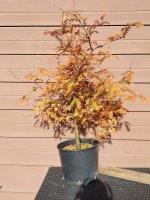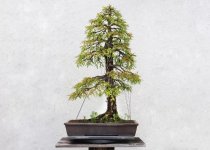defra
Masterpiece
Hi in 2017 or 2018 i bought this pencil thick metasequoia seedling.
Ive been growing it to develop a trunk but at the moment i am wondering anout the next steps.
The ones i see growing outside the older trees all are realy tapered so that makes me wonder how to continue, if i just was let it grow will that come naturaly or am i just going to trunk chop it....
I want it to be straight and tapered before i will start thinking about branches.
If i trunk chop it i am afraid it will end up looking like this: (example from google)

Its not the end of the world but i kinda feel like it looses its natural feel for me with this species.
Ive tried to let a small branch that sprouted grow straight up by just guide it allong the trunk with a piece of wire but it died and now im wondering how to proceed.
Its up for a repot in spring 2025 to see how the roots develloped i expect i need at least 5 more years to reach the thicknes of trunk i want...
If anyone has experience or examples please share them with me!
(In the meantime ill search some info also on google and bnut)
This is my metasequoia to show where i am at its no longer a small stick but a large stick in a pot !

Ive been growing it to develop a trunk but at the moment i am wondering anout the next steps.
The ones i see growing outside the older trees all are realy tapered so that makes me wonder how to continue, if i just was let it grow will that come naturaly or am i just going to trunk chop it....
I want it to be straight and tapered before i will start thinking about branches.
If i trunk chop it i am afraid it will end up looking like this: (example from google)

Its not the end of the world but i kinda feel like it looses its natural feel for me with this species.
Ive tried to let a small branch that sprouted grow straight up by just guide it allong the trunk with a piece of wire but it died and now im wondering how to proceed.
Its up for a repot in spring 2025 to see how the roots develloped i expect i need at least 5 more years to reach the thicknes of trunk i want...
If anyone has experience or examples please share them with me!
(In the meantime ill search some info also on google and bnut)
This is my metasequoia to show where i am at its no longer a small stick but a large stick in a pot !




